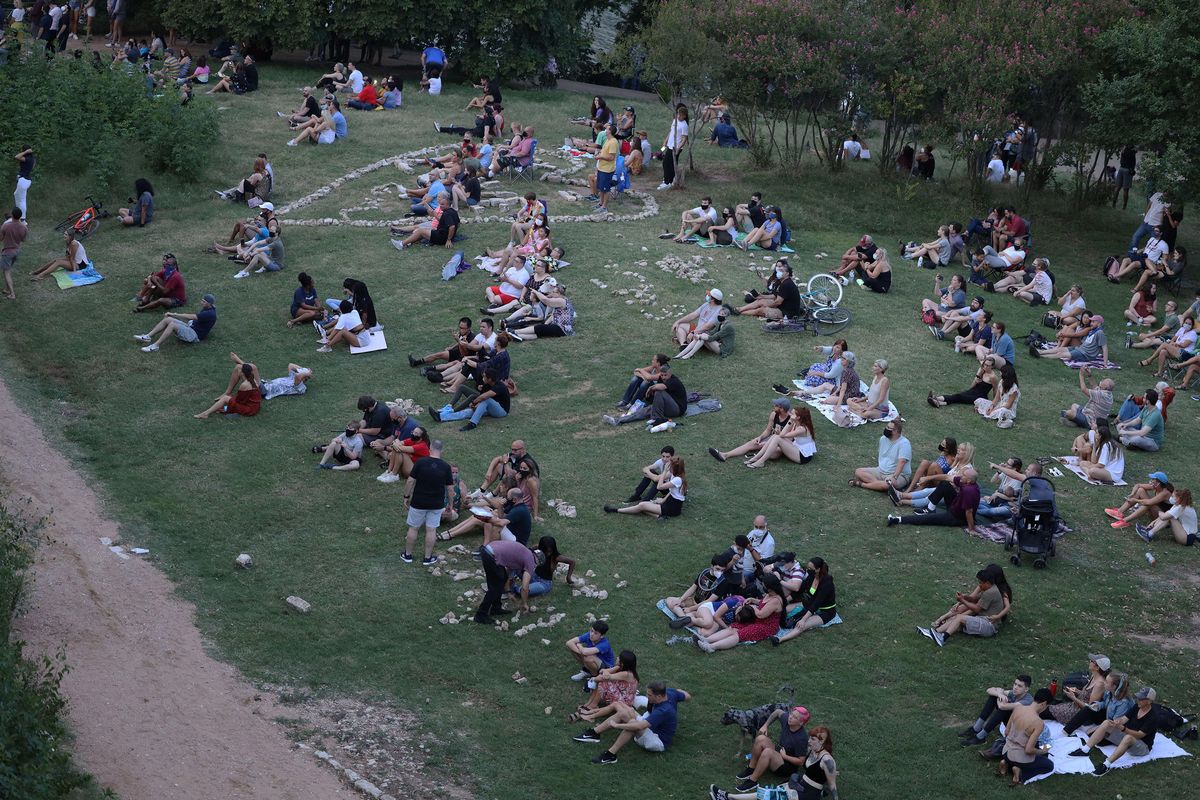Will Austin bat-watching crowds stay? Only by keeping distance, city says

AUSTIN, Texas – On the grass under the Congress Avenue bridge last weekend, dozens sat in clumps a few feet away from one another, talking and eating, to watch the bats come out.
More stood on top of the bridge, swelling the size of the crowd to more than 100 people. About half wore masks.
When the bats started to fly out from under the bridge, after 8:30 p.m., watchers on the ground rushed to the front of the Ann and Roy Butler Hike and Bike Trail, seeming to forget to keep their social distance.
It almost felt like last summer.
Now, more than three months after the city first issued stay-at-home orders to stop the spread of the coronavirus, Austin Mayor Steve Adler announced a new public health decree that prohibits gatherings of more than 10 people.
So what do the latest orders mean for those willing to risk catching the virus – which has killed more than 2,500 Texans and more than 130 in the Austin area – to watch the more than 1.5 million Mexican free-tailed bats that come out each night from under the Ann W. Richards Congress Avenue Bridge?
“This is like any other gathering that isn’t confined to a venue or business. We would ask people to adhere to social distancing,” a city spokesperson said in a statement.
Adler’s order, which went into effect Friday and expires Aug. 15, comes on the heels of Gov. Greg Abbott’s decision to require residents of Texas counties with 20 or more confirmed cases of the coronavirus to wear masks in public spaces.
“This new local order – takes full advantage of new tools in the governor’s latest orders – making masks mandatory and enforceable while also prohibiting groups over ten,” Adler said in a written statement. “It is now on each of us to do our part – for our communities and for our loved ones – especially this holiday weekend.”
Adler’s order does not address bat-watching specifically. It does say that outdoor social gatherings “outside of a single household or dwelling should be avoided or minimized.” Unless everyone is from a single household or residence, gatherings of more than 10 people are prohibited (barring some exceptions in Abbott’s orders).In May, Gov. Greg Abbott began reopening many of the state’s businesses that had been shuttered in the spring to stop the spread of the virus. But since Memorial Day, Texas coronavirus cases and hospitalizations have skyrocketed, with the state clocking more than 8,000 new cases on Wednesday alone.
Around the same time that the bat-watchers had gathered last weekend, Abbott reordered bars to be closed, again reduced restaurant capacity to 50% and banned gatherings of 100 or more people to stop the virus’ resurgence.
Now the state is requiring masks in public, too.
Abbott’s latest order on masks included a proclamation giving mayors and county judges the power to restrict some outdoor gatherings of more than 10 people, and mandating that, “with certain exceptions, people cannot be in groups larger than 10 and must maintain 6 feet of social distancing from others.”
All of which brings us to back to the bat-watchers on Lady Bird Lake. Changes in the climate have altered the timing of bat-watching season, which historically had been between March and November. In past summers, crowds could easily grow into the hundreds.
The city says it will work with police, code enforcement and park rangers to make sure that large groups gather safely.
“If people aren’t social distancing, they may be asked to leave,” the city spokesperson said.But the city’s enforcement strategy “remains one of education and voluntary compliance,” said David Green, a media relations manager for the city.
The city also asked those who have been protesting in recent rallies against police brutality to find another way to demonstrate that avoids spreading the coronavirus.
“While we understand and support people’s right to protest and make their voices heard, Austin is currently experiencing uncontrolled community spread of COVID-19. Now, more than ever, we must come together as a community to look out for one another,” Green said.
“Practicing good mitigation techniques is paramount to preventing further spread of the virus. To the extent possible, we would encourage those engaged in protests to leverage alternate methods of expression that don’t put people at an undue risk for continued exposure to the disease by gathering in large groups,” he said.
To report a gathering of around 100 people, Austin residents can call 311 and be forwarded to the appropriate department, the city said.
Between June 26, when Abbott first issued orders on crowd sizes, and June 30 at 1 p.m., the city received 195 reports of social distancing and occupancy violations.
The city does not track events in the reports, so it is unclear how many of those reports were about bat-watchers or protesters.